In this article, you will learn about different types of circuit breakers with their working and applications are explained with Pictures.
If you need a PDF file? Just download it at the end of the article.
What is a Circuit Breaker?
A circuit breaker is a safety device that protects an electric circuit from damage caused by an overcurrent or short circuit. The primary function of this device is to interrupt the current flow to shield the equipment and prevent the risk of fire.
An electrical circuit breaker can be operated both manually and automatically to control and protect the electrical power system. Since modern power systems operate under heavy currents, special attention should be required to ensure that they can safely interrupt the arc generated during the circuit breaker’s shutdown.
Compared to a fuse, which operates only once and requires replacement, a circuit breaker can be reset manually or automatically to resume regular operation. These are available in a variety of sizes, from small appliances that protect low-current circuits or individual home appliances.
In addition, they are also made in large switchgear sizes. These are designed to protect the high-voltage circuits that feed the entire city. Let’s discuss its parts and functions below.
Read More: What are the different Types of Capacitors? [PDF]
Circuit Breaker Parts
Following are the parts of a circuit breaker:
- Frame or external casing
- Operating mechanism
- Electrical contacts
- Arc extinguisher
- Trip unit
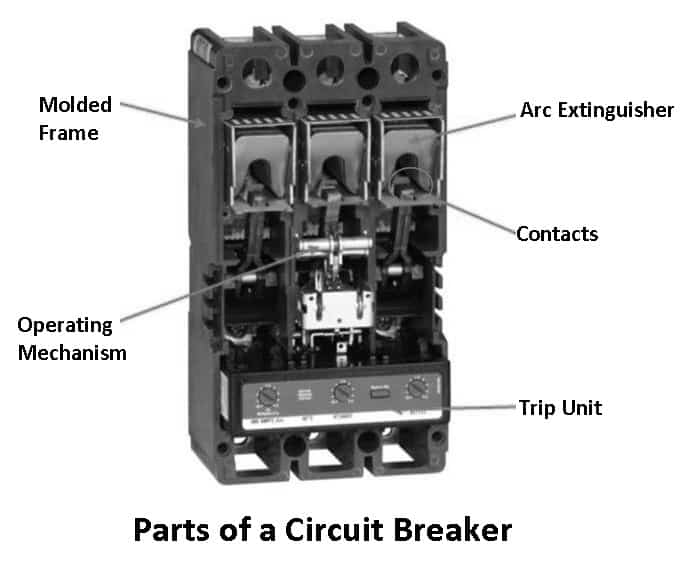
#1 Frame or external casing
As the name suggests, the frame protects all the internal components of the circuit breaker. It also supports the components and provides insulation to contain the arc. Depending on the current and voltage used, they are further available in three forms: molded, insulated, and metal.
#2 Operating Mechanism
All types of circuit breakers use some method to disconnect the power supply. These typically include spring-loaded switches, solenoid, hydraulic, and pneumatic switches. Its function is to open or close the contacts of the circuit breaker.
#3 Electrical contacts
The function of contacts is to pass the current through the circuit breaker when they are closed. Generally, a circuit breaker has two electrical contacts: a static contact and a temporary contact.
#4 Arc Extinguisher
This usually extinguishes the arc in the event of a fault. When the contacts are disconnected, electricity can jump through the gap between the end parts of the contact. This causes an arc of electricity that can reach very high temperatures. A circuit breaker uses an arc suppression mechanism (arc extinguisher) to prevent the damage and arc from re-creating itself.
#5 Trip Unit
Trip unit helps to detect abnormal current flow in the event of overcurrent and short circuit. It causes the operating mechanism to open the contacts. An open circuit will not conduct electricity because the air or other insulator has blocked the current flow in the loop.
Read Also: What is an Insulator, and how does it work? [PDF]
Working of Circuit Breaker
Circuit breakers are made up of pairs of stationary and moving metal contacts, in addition to an operating coil. Under normal cases, when the circuit is closed, these contacts touch each other, allowing an electric current to flow.
For example, these moving contacts are held together due to mechanical pressure exerted by some other mechanism such as a spring or compressed air. Beneath a closed circuit breaker, current-carrying contacts known as electrodes engage each other due to the pressure of a spring.
Switching and maintenance of the system are done either by opening or closing the circuit breaker arms. These devices are opened by applying pressure to the trigger. When there is a fault in the current flowing through any part of the system, the breaker’s trip coil is energized, pulling one away from the other, thereby opening the circuit.
Arc Occurance in a Circuit Breaker
In the operation of every circuit breaker, the arc is the one that must be observed. Hence, the arcing phenomenon in circuit breakers occurs during faulty cases. For example, when there is an wide flow of contacts before having a defensive approach and initiating contacts.
The contact area quickly decreases when the contacts are in the open position, and the current density increases due to the high current. This phenomenon determines the temperature rise and the heat production sufficient for the ionization interruption medium.
The ionized medium acts as a conductor and receives the arc between the contacts. The arc makes a minimum resistance path for the contacts, and a huge current will flow while the arc is present. This condition cut off the operation of the circuit breaker.
Read Also: Different Types of Electric Motors: Their Working & Uses [Explained]
Types of Circuit Breaker
Following are the types of circuit breakers that are described below:
- AC circuit breaker
- High voltage circuit breaker
- Low voltage circuit breaker
- Miniature circuit breaker
- Molded case circuit breaker
- DC circuit breaker
- HDVC circuit breaker
- Oil circuit breaker
- Bulk oil circuit breaker
- Minimum oil circuit breaker
- Air circuit breaker
- Air blast circuit breaker
- SF6 circuit breaker
- Vacuum circuit breaker
- Single pole circuit breaker
- Double pole circuit breaker
#1 AC Circuit Breaker
An AC circuit breaker is a safety switch usually built into your home’s electrical system. It looks like a switch that helps to stop the flow of electricity to any component or device that consumes a lot of power.
#2 High Voltage Circuit Breaker
Large power transmission networks are usually controlled by high-voltage type circuit breakers. This type of circuit breaker is used with a voltage rating of more than 600 volts. These are powered by solenoids, with current sensing protective relays driven through current transformers.
High-voltage AC circuit breakers are available with ratings up to 765 kV and 1200 kV breakers. These circuit breakers can be arranged to allow tripping to a single pole of a three-phase line rather than tripping all three poles. Circuit breakers with all three poles are used for certain classes of faults, improving the system’s stability and availability.
#3 Low Voltage Circuit Breaker
A low voltage circuit breaker is suitable for circuits rated at 600 volts or less. The most commonly used low-voltage circuit breaker is a molded case circuit breaker. Low-voltage circuit breakers are commonly seen in domestic, commercial, and industrial applications.
Low-voltage molded case circuit breakers may have an electric motor to open and close them under remote control. These types are also used for direct-current (DC) applications, such as DC metro lines.
#4 Miniature Circuit Breaker
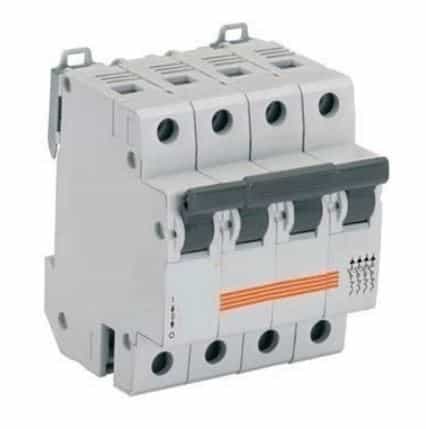
These types of circuit breakers serve as a substitute for fuses and are used to protect the circuit from excess current. Miniature circuit breakers are automatic switches that opens when the current flowing through them exceeds the value for which they are set.
They protect low voltage circuits 240/415V AC with a wide range of current ratings below 125V. This circuit breaker does not need to be replaced every time. If a fault occurs, it can be reused. These are primarily in household, light-industrial, and commercial applications.
| Advantages of MCB | Disadvantages of MCB |
|---|---|
| This type of circuit breaker is more liable to current than a fuse. | They are more expensive than fuses. |
| By its use, the faulty area of the electric circuit can be easily identified. | The cost of an MCB distribution board is also costlier. |
| It can provide a better interface with the help of a knob as compared to a fuse. | Installment and repair are expensive as compared to fuse. |
#5 Molded Case Circuit Breaker
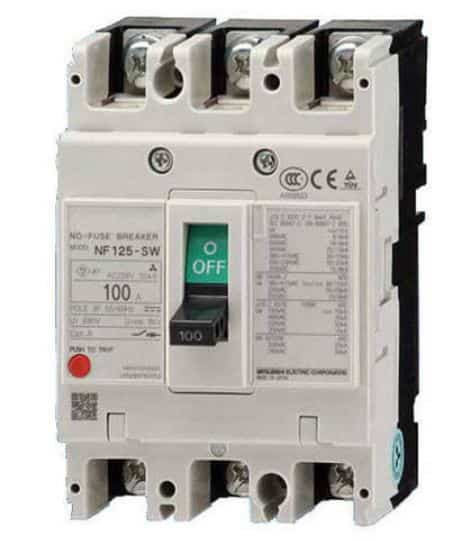
The molded case circuit breaker is a circuit breaker with a high current rating of up to 2500 amps. These are generally seen where the current rating exceeds the limits of the MCB (Miniature Circuit Breaker).
This circuit breaker works on a thermal-magnetic tripping mechanism where the thermal mechanism is used for overloading and magnetic is used for short circuit conditions. It can quickly dissipate a current of around 10k – 200k amps. They protect equipment like generators, electric feeders, capacitor banks, motors, etc.
| Advantages of MCCB | Disadvantages of MCCB |
|---|---|
| MCCB is compact and saves a lot of space in panel design. | The cost of MCCB is more as compared to the MCB-type circuit breaker. |
| They can protect electrical equipment from faulty conditions. | This type of circuit breaker requires regular maintenance. |
| It could easily be reset or restarted immediately if a fault is found. | If a lot of MCCB is used inside the panelboard, it must be cooled. |
Read Also: How does a Refrigeration System work?
#6 DC Circuit Breaker
A DC circuit breaker protects electrical equipment operating with DC. It has additional arc extinguishing measures. These are relatively new technologies for most homeowners because most appliances are used in the homework with AC.
These circuit breakers use 24 VDC to 48 VDC programmable logic controllers (PLCs). Though both AC and DC breakers look alike but internally, they work very differently. During an overload, the internal contacts of both the AC and DC circuit breakers are separated to protect the circuit.
#7 HVDC Circuit Breaker
HVDC circuit breaker is a switching device that interrupts the normal flow of current in the circuit. These circuit breakers provide a very efficient way of power transmission over long distances. Nowadays, there are used in various green energy generation.
When the HVDC circuit breaker opens, the switch closes in the LC circuit. Due to the charged capacitor, the discharging current starts flowing opposite to the load current carried by the circuit breaker. Due to this, the arcing current begins to produce many natural zeros. These are suitable for reticulated DC grids and multi-terminal DC links.
| Advantages of HVDC Circuit Breaker | Disadvantages of HVDC Circuit Breaker |
|---|---|
| They provide both high efficiency and fast switching. | HVDC requires conversion, switching, control, availability, and maintenance. |
| It can allow the system to be much smaller than other traditional equipment. |
#8 Oil Circuit Breaker
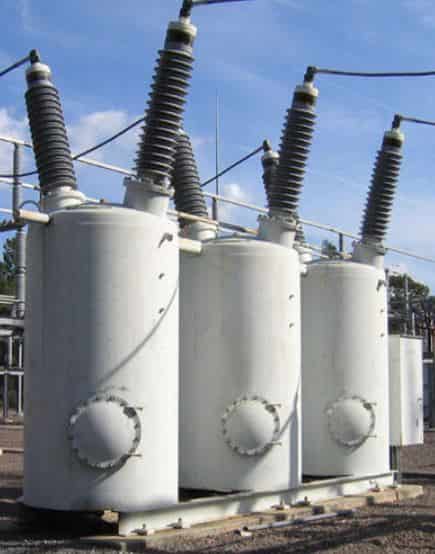
These types of circuit breakers use an insulating oil (which has better dielectric strength than air). The insulating oil is a dielectric medium to extinguish the arc and break the circuit safely. The moving contacts and stationary contacts are immersed inside the insulating oil.
When separation of current occurs, the carrier contacts in the oil begin at the moment of separation of the arc contacts in the circuit breaker. This is because the arc in the oil vaporizes and decomposes into gas, eventually forming a bubble around the arc. They are used in power grids, substations, powerlines, and transmission and distribution systems.
| Advantages of Oil Circuit Breaker | Disadvantages of Oil Circuit Breaker |
|---|---|
| These types use less oil and have higher dielectric strength. | Due to the presence of oil, it is possible to become an explosive mixture. |
| The oil in the breaker can absorb the energy of the arc when it expands. | It is flammable and can cause a fire hazard. |
| Its use can reduce the risk of fire. | These types of circuit breakers have a high arcing time. |
#9 Bulk Oil Circuit Breaker
These types of circuit breakers use oil arc quenching media as well as insulating media between the current-carrying contacts and the earthing parts of the breaker. The amount of oil required in this circuit breaker depends on the system voltage.
A bulk oil circuit breaker requires a large tank which increases the cost and also increases the weight of the circuit breaker. This type requires less space because the oil quality is low. In this, a slight contact separation is sufficient to extinguish the arc.
#10 Minimum Oil Circuit Breaker
Minimal circuit breaker uses oil as the interrupting media. This type of circuit breaker will keep the interrupting unit at the live potential in an insulating chamber. Since less oil is required, it is called a minimum oil circuit breaker.
Read Also: Types Of Resistors And Their Uses [Explained With Symbols]
#11 Air Circuit Breaker
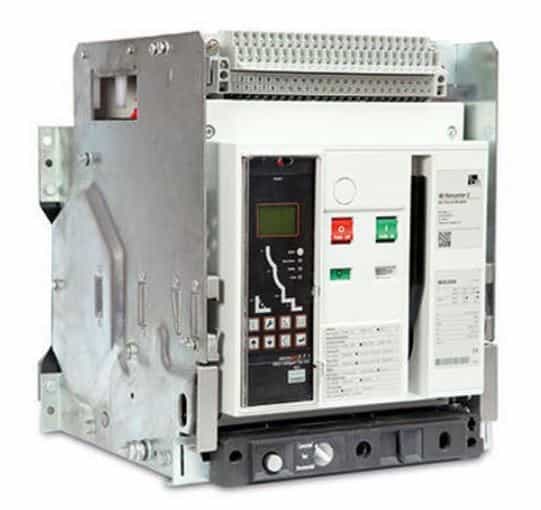
As the name suggests, this circuit breaker operates via air. Air circuit breakers protect low voltage circuits, mainly activating and cutting off the high currents.
In some countries, air circuit breakers are replaced with oil-type circuit breakers because it works efficiently. Thus the importance of ACB is still a better option for using air circuit breakers up to 15KV. ACBs are used as protective devices for industrial plants and electrical machines such as capacitors, generators, transformers, etc.
| Advantages of Air Circuit Breaker | Disadvantages of Air Circuit Breaker |
|---|---|
| Since the circuit breaker uses air as the medium, it is cheap and chemically stable. | In case of arc interruption, it produces a high noise when air is released into the open environment. |
| The air blast circuit breaker has the capability to operate at high speed. | The problem of cutting off current exists in the air blast circuit breaker. |
| The air circuit breaker eliminates the fire hazard, unlike the oil circuit breaker. | There is trouble with re-striking voltage. |
#12 Air Blast Circuit Breaker
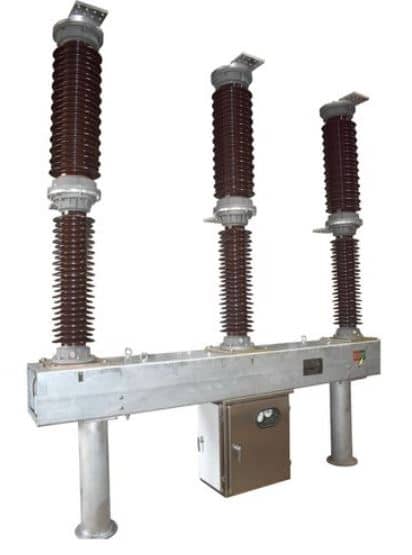
The Air blast circuit breaker employs a high-pressure air blast as an arc extinguishing medium. This type of circuit breaker is used in open terminal HV applications with a voltage range of 245 kV, and 400 kV up to 765 kV, especially where fast breaker operation is required.
Compared to SF6 and vacuum type, air blast circuit breaker is rarely used nowadays. Air blast circuit breaker uses compressed air or gas as the circuit breaking or interrupting medium. Air blast circuit breaker offers many features such as fast operation, auto closure, minor maintenance, and much more.
#13 SF6 Circuit Breaker
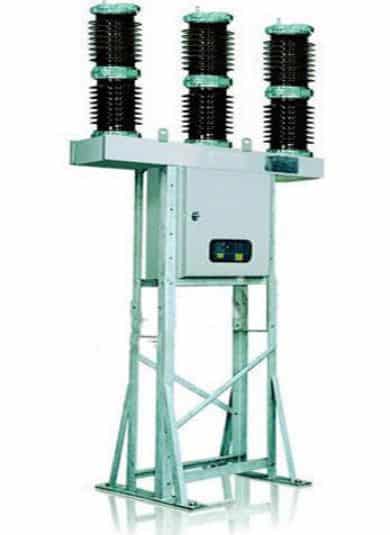
The SF6 circuit breaker is a type of circuit breaker that uses pressurized Sulphur Hexafluoride gas to extinguish the arc. It is a strong dielectric gas with better insulating and arc quenching properties than air or oil. It is commonly used for arc quenching in high voltage circuit breakers up to 800 kV in power stations and electrical grids.
When an arc is struck between the contacts, it absorbs the free electrons from it and converts them into negative ions that are heavier than electrons. SF6 gas has low mobility which increases the dielectric strength of the medium because the movement of charges is responsible for the current flow.
| Advantages of SF6 Circuit Breaker | Disadvantages of SF6 Circuit Breaker |
|---|---|
| The benefit of SF6 gas is that it is inflammable and chemically stable. | These are expensive due to the high cost of the SF6. |
| It has decomposition products so there is no risk of fire or explosion. | Internal parts in a clean and dry environment require cleaning during periodic maintenance. |
| Due to the high dielectric strength of SF6, the electrical clearance is greatly reduced. | For transportation of a special facility, it requires maintenance of gas quality. |
#14 Vacuum Circuit Breaker
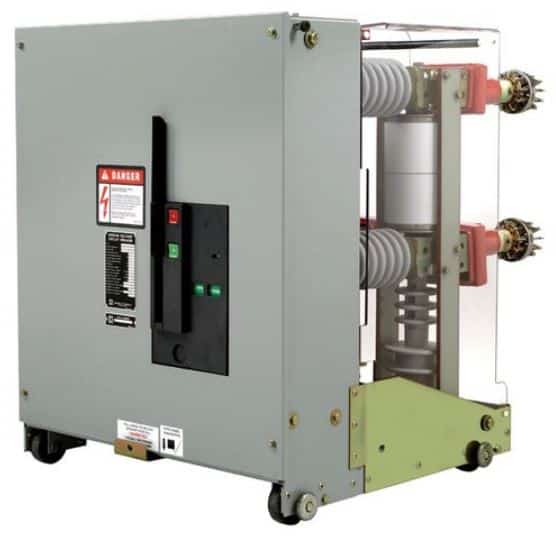
This type of circuit breaker is mostly used in high voltage electrical systems to perform a similar function to the breakers in a home electrical panel. The function of this device is to cut off power to an electrical outlet in case of a short circuit or electrical fault to allow manual disconnection of the circuit so that it can be repaired.
A unique feature of vacuum circuit breakers is that they have free space. The performance of a vacuum circuit breaker mainly depends on the material used for current-carrying contacts such as Cu/Cr.
| Advantages of VCB | Disadvantages of VCB |
|---|---|
| It has a longer service life than other types of circuit breakers. | The drawback of VCB is that it is unviable at voltages above 38 kV. |
| They are compact in size and pose no potential for a fire hazard. | Generating a vacuum requires high technology. |
| The vacuum has high dielectric strength and does not produce gas after the operation. | At high voltage the circuit breaker becomes costly. |
#15 Single Pole Circuit Breaker
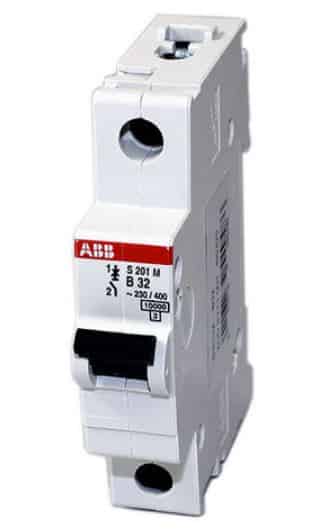
In electrical panels, single-pole breakers look like narrow switches. Single pole circuit breakers are used for many applications such as general lighting outlets, vacuums, fans, power tools, curling irons, outdoor lighting, radios, computers, DVD players, and air compressors.
Single pole circuit breakers are typically wired with a hot wire and a neutral wire. If overload occurs in a single-pole breaker circuit, only that specific breaker will trip.
#16 Double Pole Circuit Breaker
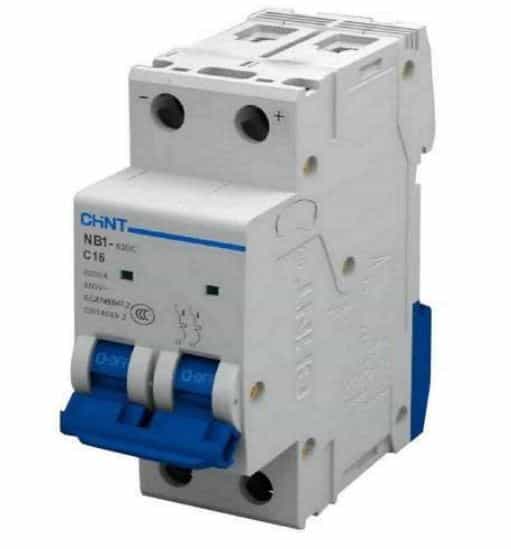
In electrical panels, double-pole breakers look like double switches. They can also be used to service devices with low voltage circuits, with central air conditioners, dryers, water heaters, baseboard heats, and even hot tubs.
Double-pole breakers consist of two hot wires connected to a neutral wire. With this design, if there is ever a short circuit in the wires of either pole, both will trip. These are typically used to service a single 240V circuit, but can also be used to service two separate 120V circuits.
Wrapping It Up
As we already discussed, a circuit breaker is the most essential part of the electric network as it protects every device from short circuits or damage. It helps in locating the fault and the area affected by it. Nowadays, vacuum and SF6 circuit breakers are widely used due to their reliability and fast operation.
Now, I hope I’ve covered everything you were looking for about “Types of Circuit Breakers”. If you still have any doubts or questions regarding this topic, leave a comment below I’ll definitely reply. If you liked it, then share this with your friends.
Want free PDFs direct to your inbox? Then subscribe to our newsletter.
Download PDF of this article:
You might like to read more in our blog:
Send the PDF of this article….
The PDF file has been sent to your inbox.
Nice
Thanks.
Please send me the PDF file
The PDF file has been sent to your inbox.
Thanks for this wonderful information.
well-articulated
You’re welcome.
Small error in printing,
Is it hvdc or hdvc?
Thanks for the correction.
Thanks for sharing these valuable and well-organized pieces of information.
Could you send the pdf.
The PDF file has been sent to your inbox.
This is very helpful notes for electrical engineering.
Please send me pdf file.
Glad you liked it. The PDF file has been sent to your inbox.
Please send me a copy of the PDF?
Good Info.
The PDF file has been sent to your inbox.
This is so helpful. Please send me a pdf file.
The PDF file has been sent to your inbox.
Please send me a copy of the PDF?
Good Info.
Thanks for the feedback. The PDF file has been sent to your inbox.
Please, send me pdf file. Thanks
You’re welcome. The PDF file has been sent to your inbox.
Please send the pdf file
The PDF file has been sent to your inbox.
Please send me the file
The PDF file has been sent to your inbox.
So use full for my country we don’t have ac breaker or such things we have only mcb and mccb it useful can I get the PDF please
I’m glad it was help for you. The PDF file has been sent to your inbox.
Please, send me pdf file. Thanks
The PDF file has been sent to your inbox.
very nice I like the explanations
Pls send PDF File
Thanks for the feedback. The PDF file has been sent to your inbox.
I wish I could have this pdf because it’s understandable and hopefully it can help in my field of electrical engineering
Thanks for your feedback. The PDF file has been sent to your inbox.
Kindly sent the download link please it’s really helpful.Thank you
You’re welcome. The PDF file has been sent to your inbox.
Kindly sent the download link please it’s really helpful 🙏🙏
The PDF file has been sent to your inbox.
Good and very educative
Thanks for your feedback.
Kindly sent the download link please it’s really helpful.Thank you
You’re welcome. The PDF file has been sent to your inbox.
kindly sent the pdf file
The PDF file has been sent to your inbox.
Very nice one I need the PDF
The PDF file has been sent to your inbox.
Kindly sent the download link please it’s really helpful 🙏🙏
The PDF file has been sent to your inbox.
I would like to have a pdf of this! It looks great
The PDF file has been sent to your inbox.
i also like to have a pdf copy of this.
The PDF file has been sent to your inbox.
This is the best notes for electrical engineering students so far
Thanks for your feedback.
Please send me pdf file the good notes
The PDF file has been sent to your inbox.